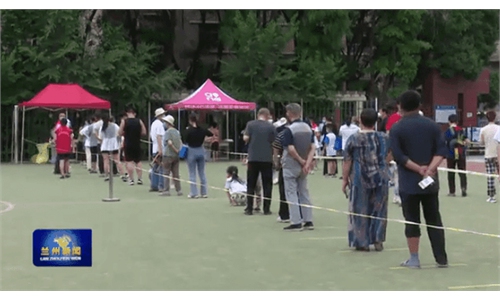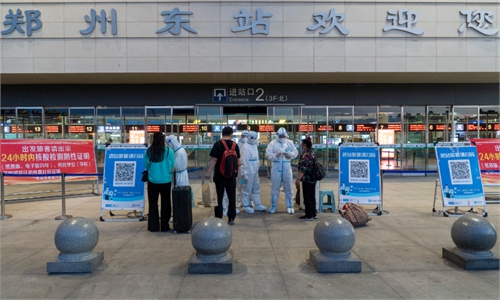Latest Omicron-fueled Lanzhou flare-up shows upward trend with transmission detected in communities

Residents from Lanzhou city in Northwest China's Gansu Province queue up to take nucleic acid tests on July 8, 2022. Photo: IC
The latest COVID-19 flare-up in Lanzhou city, Northwest Gansu Province is in the rising period with transmission of highly contagious Omicron subvariant BA.2.38 in communities detected.
Lanzhou, capital of Gansu, registered 26 new local confirmed COVID-19 patients between 10 am on Wednesday and 10 am on Thursday, bringing the tally of confirmed cases of this outbreak to 48 as of 10 am on Thursday, the city's authority announced on Thursday.
Besides, the city has registered 159 asymptomatic infections as of 10 am on Thursday.
The outbreak caused by the highly contagious Omicron variant has shown an upward trend of transmission at communities with short interval of intergenerational transmission, strong infectivity, and swift transmission speed, Yang Dezhi, deputy mayor of Lanzhou city people's government, said during the press briefing on Thursday.
Genetic sequencing analysis showed that the confirmed cases of this round of outbreak are caused by the Omicron subvariant BA.2.38 which is highly contagious and latent and hard to detect, according to a press briefing on the provincial epidemic prevention and control work held on Thursday afternoon.
The Omicron subvariant BA.2.38 still belongs to the BA.2 variant with similar transmission capacity to BA.1 and BA.3, but is more widespread, Yang Zhanqiu, deputy director of the pathogen biology department at Wuhan University, told the Global Times on Thursday.
With a two- to three-day incubation period, it has weaker transmission capacity compared with the newly discovered BA.5 variant, Yang said. It is also less pathogenic than the earlier COVID-19 strains, and most infected people are asymptomatic, Yang added.
Since the first confirmed case for this flare-up was discovered on July 8, the city with a population of 4.38 million has conducted five rounds of mass nucleic acid testing in the city's major downtown districts and key counties as of Thursday noon.
So far, 39 positive infections have been discovered in the fourth round of testing. As of 10 am on Thursday, a total of 8,982 close contacts and 6,388 contacts of these close contacts have been identified and placed under quarantine.
There are a total of 25 high-risk areas and 29 medium-risk areas in Lanzhou at present. A week-long temporary management and control measure has been taken in the four major downtown districts in Lanzhou since Monday.
Besides, management and control on the personnel departing from Lanzhou have also been strengthened to prevent spillover cases to other places. Railway passengers leaving Lanzhou have to present negative nucleic acid test results within 24 hours and flight passengers who have stayed in the four major districts during the seven days before their departures have to obtain negative nucleic acid testing results within 24 hours. Flight passengers who have a travel history in other high- and medium-risk areas have to present negative results within 48 hours.
According to Yang, the epidemic is still in the stage of the first week, so it is normal to show an upward trend. But the expert predicted that the flare-up will not further develop and cause a large-scale epidemic.
As of Thursday noon, a total of 56 confirmed cases and 175 asymptomatic infections have been registered across nine cities and prefectures in Gansu during this outbreak since July 8.
There are currently 43 high-risk areas and 54 medium-risk areas across Gansu.
Global Times



